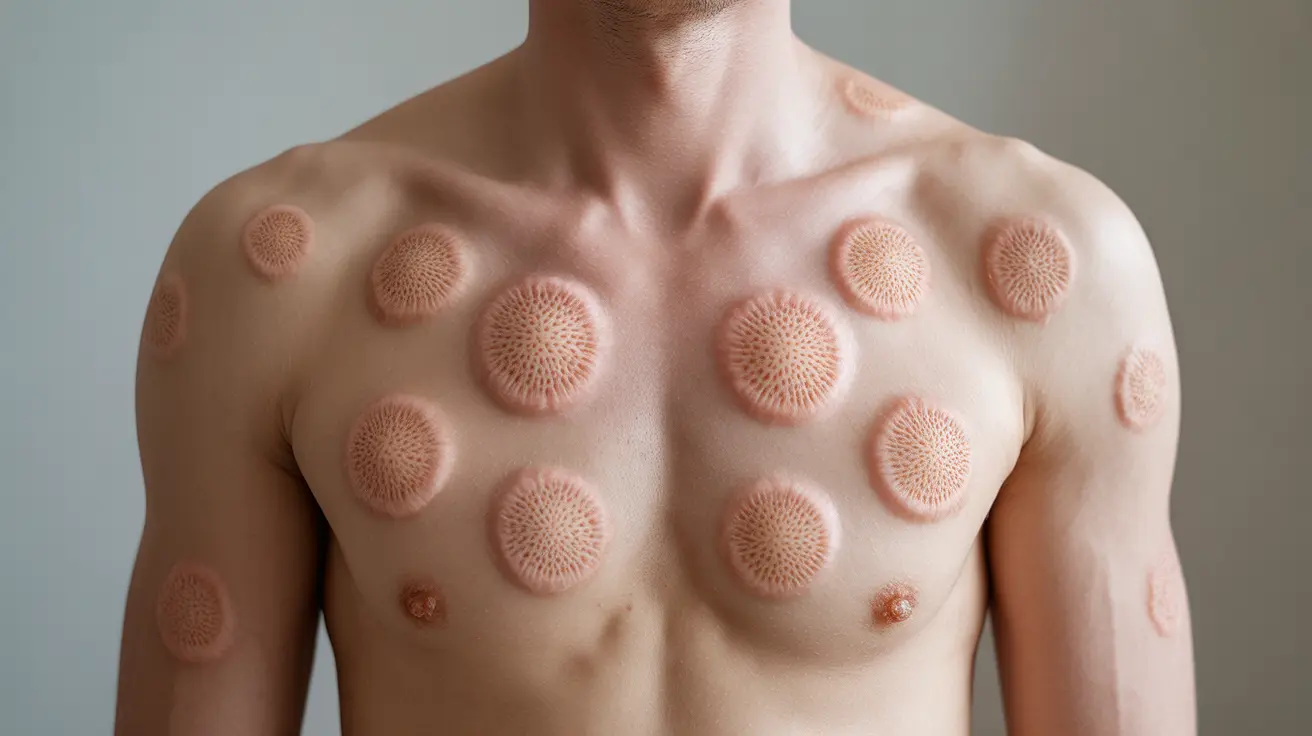Pityriasis rosea is a temporary skin condition that affects people of all ages, though it's most common in young adults. This distinctive rash typically begins with a single "herald patch" and develops into a pattern that resembles a Christmas tree on the torso. While it may cause concern when it first appears, understanding its characteristics and treatment options can help ease anxiety about this generally harmless condition.
This comprehensive guide will explore the key aspects of pityriasis rosea, including its symptoms, causes, diagnosis, and treatment options. We'll also address common concerns about its contagious nature and long-term effects on the skin.
Understanding the Herald Patch and Rash Pattern
The initial sign of pityriasis rosea is typically a large, oval-shaped patch known as the "herald patch" or "mother patch." This patch usually appears on the torso and can be 2-10 centimeters in size, featuring a salmon-pink color with a slightly raised, scaly border.
Within one to two weeks after the herald patch appears, smaller patches develop across the torso and upper arms. These secondary rashes typically follow the lines of the ribs in a distinctive pattern that resembles tree branches, leading to its Christmas tree-like appearance.
Causes and Transmission
While the exact cause of pityriasis rosea remains uncertain, research suggests it may be triggered by viral infections, particularly human herpesvirus 6 (HHV-6) and human herpesvirus 7 (HHV-7). However, the condition is not considered contagious, and there's no evidence of it spreading from person to person through direct contact.
Certain factors may increase the likelihood of developing pityriasis rosea, including:
- Seasonal changes (more common in spring and fall)
- Stress
- Compromised immune system
- Young adult age group (10-35 years)
Diagnosis and Similar Conditions
Healthcare providers typically diagnose pityriasis rosea through visual examination and medical history. The distinctive pattern and appearance of the rash, along with the presence of the herald patch, often make diagnosis straightforward. However, other skin conditions may sometimes look similar, including:
- Tinea corporis (ringworm)
- Seborrheic dermatitis
- Psoriasis
- Secondary syphilis
In some cases, additional tests may be necessary to rule out these conditions and confirm the diagnosis.
Treatment Options and Management
While pityriasis rosea typically resolves on its own within 6-8 weeks, several treatments can help manage symptoms and potentially speed up recovery:
- Over-the-counter antihistamines for itching
- Topical corticosteroid creams
- Light therapy (phototherapy) in severe cases
- Moisturizing lotions to soothe dry, irritated skin
For most people, the condition is mild and requires minimal intervention beyond symptom management.
Recovery and Long-term Outlook
Most cases of pityriasis rosea clear up without complications within two months. The rash rarely leaves permanent marks or scars, though some individuals may experience temporary darker or lighter patches that gradually fade over time. Recurrence is uncommon, affecting only about 2-3% of people who have had the condition.
Frequently Asked Questions
What are the typical symptoms and rash pattern of pityriasis rosea? The condition typically begins with a large herald patch, followed by smaller oval patches arranged in a Christmas tree pattern on the torso. The rash may be slightly itchy and salmon-pink in color with scaly borders.
What causes pityriasis rosea and is it contagious? While the exact cause isn't fully understood, it's believed to be related to viral infections, particularly human herpesviruses 6 and 7. The condition is not contagious and cannot be spread through direct contact.
How is pityriasis rosea diagnosed and differentiated from other skin conditions? Diagnosis is primarily based on visual examination and the presence of the characteristic herald patch and Christmas tree pattern. Healthcare providers may perform additional tests to rule out similar-looking conditions.
What treatment options are available to relieve itching and speed up recovery from pityriasis rosea? Treatment options include antihistamines, topical corticosteroids, light therapy, and moisturizing lotions. Most cases resolve on their own within 6-8 weeks.
Can pityriasis rosea be prevented, and does it usually leave permanent marks or scars? There is no known prevention method since the exact cause is unclear. The condition rarely leaves permanent marks or scars, though temporary skin discoloration may occur and typically fades over time.




